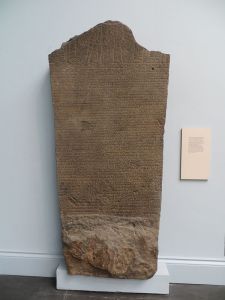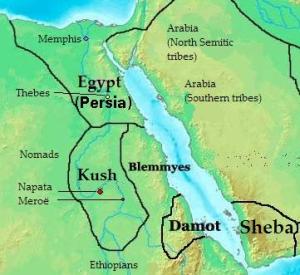
Amanirenas was a great Candace, queen, of the Nubian kingdom, mother to queen Amanishakheto, and grandmother to queen Amanitore. Amanirenas was a great warrior queen. She built considerable pyramids and temples at Wad Ban Naqa, where she was buried with great treasures.
Her full name and title was Amnirense qore li kdwe li (“Ameniras, Qore and Kandake“). She reigned from about 40BC to 10BC, and is one of the most famous Kandakes, because of her role leading Kushite armies against the Romans in a war that lasted five years, from 27 BCE to 22 BCE. After an initial victory when the Kushites attacked Roman Egypt, they were driven out of Egypt by Gaius Petronius and the Romans established a new frontier at Hiere Sycaminos (Maharraqa). Amanirenas was described as brave, and blind in one eye. Some say that her name means ‘Amani is her name’. Amani is the Nubian name for Imana/Amon, Unique God of Africa.

Meroitic inscriptions give Amanirenas the title of qore as well as Kandake suggesting that she was a ruling queen. She is usually considered to be the queen referred to as “Candace” in Strabo‘s account of the Meroitic war against the Roman Empire. Her name is associated with those of Teriteqas and Akinidad. King Teriteqas died shortly after the beginning of the war. She was succeeded by Akinidad (possibly the son of Teriteqas) who continued the campaign with his mother Amanirenas. Akinidad died at Dakka c. 24BC. The loss of one eye during battle made Amanirenas even stronger and braver. She despised death, and her fearlessness forced the admiration of Strabo, the Greek historian, who said, “this queen has a courage above that of her gender.”
When Aelius Gallus, the Prefect, or chief magistrate, of Egypt, was absent on a campaign in Arabia in 24 BC, the Kushites launched an attack on Egypt. Amanirenas and Akinidad defeated Roman forces at Syene and Philae, and drove the Jews from Elephantine Island. They returned to Kush with prisoners and loot, including several statues of Emperor Augustus ; the Queen buried a bronze likeness of the Emperor beneath the entranceway to her palace so that she and all who came and went could tread on the head of her enemy. The head, found in Meroë in 1912, now resides in the British Museum

The Kushites were driven out of Syene later in the year by Publius Petronius, who now held the office of Roman Prefect in Egypt. According to a detailed report made by Strabo, the Roman troops advanced far into the Kingdom of Kush, and finally reached Napata. Although they withdrew again to the north they left behind a garrison in Qasr Ibrim (Primis), which now became the border of the Roman Empire. The Kushites made a renewed attempt to seize Primis, but Petronius forestalled this attempt.
A peace treaty was signed between the Meroites and Augustus in the year 21/20 BC, which continued until the end of the third century AD, with relations between Meroë and Roman Egypt remaining generally peaceful during this time. However, the Kingdom of Kush had begun to fade as a power by the first or second century AD.

Thereafter a preponderant place falls to two queens, Amanirenas and
Amanishakheto. Their husbands remain forgotten and we do not even know the name of Amanishakheto’s. The throne was also occupied for some years by a king, the former prince Akinidad, son of Queen Amanirenas and King Teriteqas. Nevertheless, it is important which of these two queens came first, both of them ‘Candace’, which is the transcription of the Meroitic title Kdke according to the tradition of the classical authors.
To learn more, check out the UNESCO funded book General History of Africa Vol.2, Ancient Civilizations of Africa, P. 307-308, Nations Negres et Culture by Cheikh Anta Diop , Presence Africaine 1979 p. 216-217, 50 Greatest Africans — Pharaoh Natakamani and Queen Amanitore & Ngola Ann Nzinga , The Kingdom of Kush by László Török, P. 198 and 461, ISBN 90-04-10448-8. Also check out the Rejected Princess website, Lisayapokama.org, and Face2FaceAfrica.com.


highly regarded and fully informative
LikeLiked by 1 person
A treasure trove of African history. What a great blog.
LikeLiked by 1 person
Thanks Tanga for the compliment! Thank you for commenting, and please keep coming, and keep commenting!
LikeLiked by 1 person
Pingback: Meroitic Palaces and Queens – ARCH 0760 S01: Palaces: Built to Impress
Pingback: Amanirenas, la reina guerrera nubia que se enfrentó a Roma - Revista de Historia
Wow what a great article !! To see a woman being called a King aka Qore and a Queen aka Qandake is astonishing …what a great Queen she was . We also thank Strabo for coming all the way to Sudan..and lastly we thank you Dr. Y
LikeLike